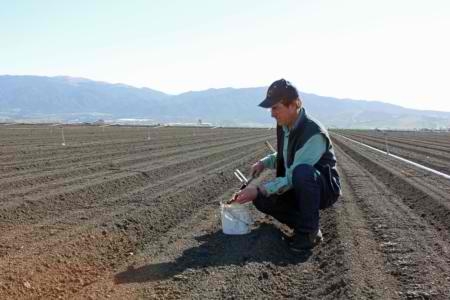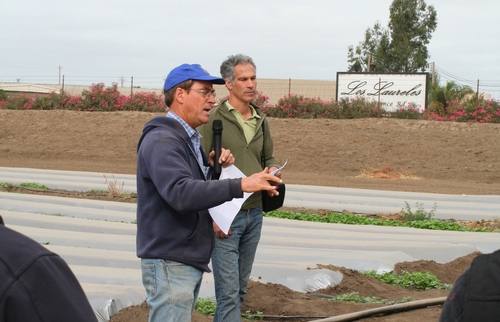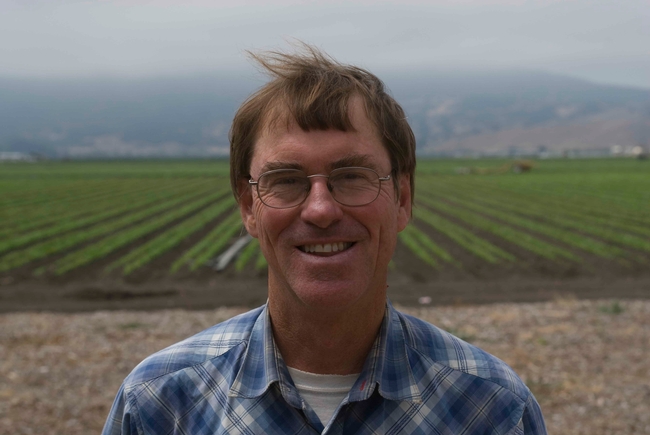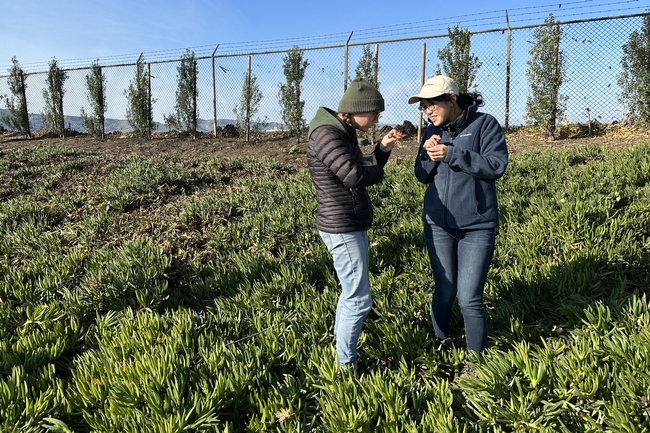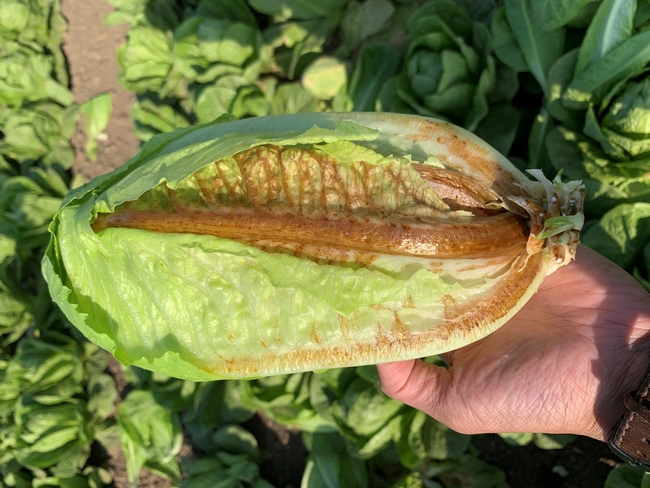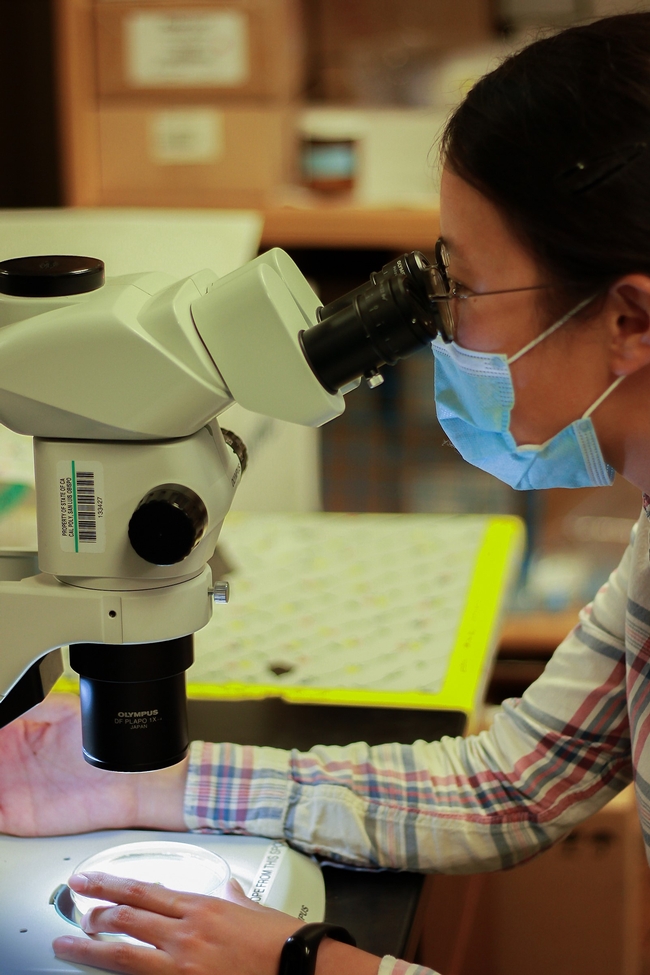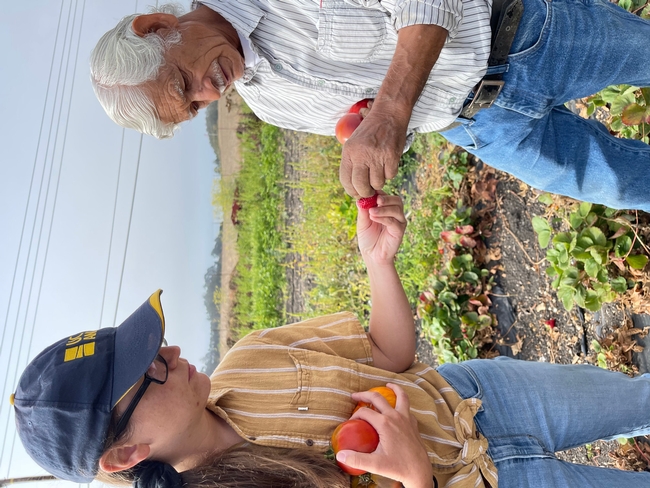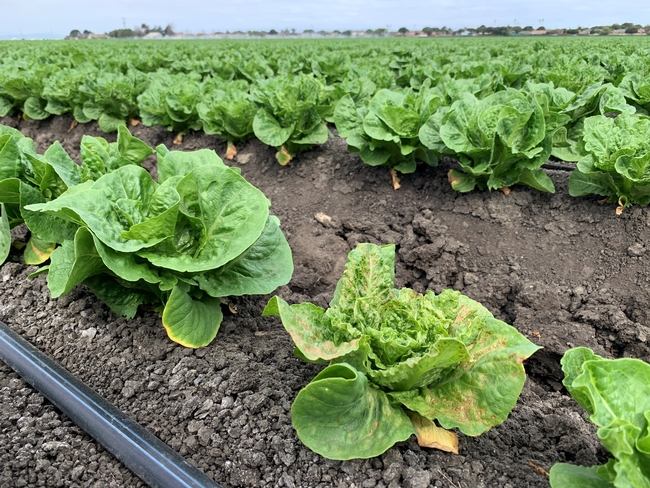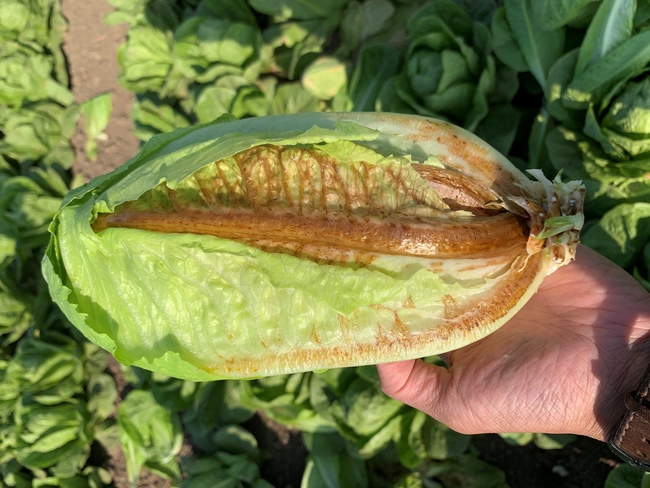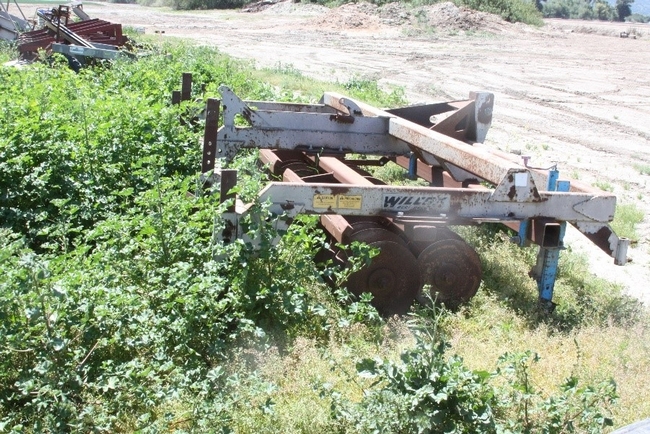Posts Tagged: Richard Smith
Richard Smith retires after 37 years of translating science into solutions for vegetable growers
For four decades, when a new plant disease infects fields of lettuce or a new regulation is issued for agriculture, vegetable farmers across the state have turned to Richard Smith, the University of California Cooperative Extension vegetable crops advisor, for answers. After 37 years of service with UCCE, Smith retired on Jan. 4.
“The whole industry has been dreading Richard's retirement!” exclaimed Jennifer Clarke, executive director of the California Leafy Greens Research Program. “Richard is a wealth of knowledge and has a great ability to translate science into real-world practical solutions.”
In the past few years, the leafy greens industry has lost millions of dollars of crops due to infections of impatiens necrotic spot virus (INSV) and Pythium wilt. Smith is among the researchers investigating the diseases.
“Richard has conducted important variety trials and led efforts in identifying the ‘top 10' weed hosts for INSV and strategies to reduce the wintertime ‘green bridge' for this virus,” Clarke said.
Smith also has kept policymakers informed of the latest research. In 2021, he testified before the Assembly Committee on Agriculture about leafy green plant diseases.
A legacy of practical advice, service to community
By serving on numerous grower and county committees and working directly with growers, Smith has built a reputation for understanding growers' needs and developing practical solutions. He has found it rewarding to see his research results used.
“The research that I have conducted with my collaborators has helped the water board to better fit their regulations to the reality of farming and to minimize the economic constraints,” Smith said.
Smith and his colleague Michael Cahn, UCCE irrigation and water resources advisor, also have become trusted and respected voices when discussing AgOrder 4.0 with the Central Coast Regional Water Quality Control Board, according to Clarke. AgOrder 4.0 calls for farmers to reduce the amount of fertilizer they apply to crops.
Field trials conducted by Smith and Cahn showed growers they could use nitrogen from high nitrate wells toward meeting a crop's nutritional needs.
“Richard has also done important research to develop nitrogen removal coefficients for AgOrder 4.0,” Clarke said. “Recently he and Eric Brennan of USDA-ARS (Agricultural Research Service) looked at cover crops and identified a system to predict shoot biomass and allow for nitrogen scavenging credits. His work has been pivotal in helping growers comply with AgOrder 4.0 in a cost-effective and realistic manner.”
Growers also use his research to manage cadmium, a heavy metal that is naturally present in soils.
“He led the effort to help growers find a best management practice that reduces cadmium uptake in various crops,” Clarke said. “The Central Coast has areas of productive agricultural land where there are naturally occurring shale deposits. The ability to amend soil to reduce plant uptake of this heavy metal has allowed these important production areas to continue to farm nutritious vegetables.”
‘Never had a bad day as a farm advisor'
Growing up in Watsonville, Smith began working at a young age in agriculture for summer jobs.
“I was in 4-H and got to know ag advisors and was always impressed by them,” Smith said. “I was fortunate to be able to work as an advisor for my career. I never had a bad day as a farm advisor – it was very satisfying working with growers and helping them with their issues.”
Smith joined UC Cooperative Extension as a farm advisor intern in San Diego County and San Joaquin County in 1985 after earning his master's degree in agronomy from UC Davis. In 1986, he moved to the Central Valley to serve as an interim farm advisor for San Joaquin County, then became a vegetable crops farm advisor for Stanislaus County in 1987.
In 1989, Smith moved to the Central Coast to serve as UCCE small farms advisor for San Benito, Monterey and Santa Cruz counties. In 1999, he transitioned to UCCE vegetable crops and weed science farm advisor for those three counties, where he served for the rest of his career.
Mentoring the next generation of scientists
“Richard was my mentor, principal investigator on my first collaborative study at ANR, speaker at several of my extension events, and a dear colleague,” said Surendra Dara, former UCCE entomology and biologicals advisor and now director of Oregon State University's North Willamette Research & Extension Center and professor of horticulture. “He is very kind, friendly, and most importantly has a good sense of humor. He is well-regarded both by his peers and stakeholders.”
Smith has been active in professional organizations, regularly attending the annual meetings of the American Society for Horticulture Science and the American Society of Agronomy. He served as president of the California Chapter of the American Society of Agronomy in 2014 and served on the board of the California Weed Science Society, which granted him the Award of Excellence in 2005 and an honorary membership in 2020.
As a public service, Smith served on the board of the Agriculture and Land-Based Training Association, and taught classes and conducted outreach to their Spanish-speaking clientele. He was a regular guest speaker for vegetable crop and weed science classes at CSU Fresno, CSU Monterey Bay, Cal Poly San Luis Obispo, Hartnell Community College and Cabrillo Community College.
As he winds down his career, Smith has been mentoring new UCCE farm advisors and scientists who have joined USDA-Agricultural Research Service in Salinas and California State University, Monterey Bay, acquainting them with local issues.
“Richard's leadership and mentorship has been critical in the development of my career as a new researcher at USDA-ARS in Salinas,” said Daniel K. Hasegawa, research entomologist in USDA-ARS's Crop Improvement and Protection Research Unit. “Richard has taught me so much about agricultural practices in the Salinas Valley and has connected me with growers and pest control advisers, which has enhanced the impact of my own research, which includes projects addressing thrips and INSV.”
Smith, who has been granted emeritus status by UC Agriculture and Natural Resources, plans to complete nitrogen research projects that are underway.
New UCCE advisors bring fresh ideas to protect lettuce from INSV, Pythium wilt
Salinas Valley lettuce growers lost about $150 million in 2022 due to diseases
A stormy winter could portend another devastating year for the lettuce industry in the Salinas Valley, which saw approximately $150 million in lost gross revenue in 2022 due to INSV (impatiens necrotic spot virus) and associated diseases. Recent drenching rains might mean more weeds – overwintering “reservoirs” for the tiny insect, the Western flower thrips, that carries INSV.
Or the extreme precipitation could benefit growers, as thrips in the soil – during their intermediate stage of development – might be drowned in the waterlogged fields.
As with so many aspects of the INSV crisis, the ultimate effects of flooded fields on thrips populations remain unknown.
“We don't know if thrips are just so persistent and so stable in that pupal stage that maybe they will emerge unaffected,” said Kirsten Pearsons, University of California Cooperative Extension integrated pest management farm advisor for Santa Cruz, Monterey and San Benito counties. “There's just so much about their biology and ecology in the Salinas Valley that we just don't know.”
The mystery of thrips, INSV and soilborne diseases (namely Pythium wilt) is why UC Agriculture and Natural Resources assigned Pearsons to the area last November and hired Yu-Chen Wang in October as UCCE plant pathology advisor for the three counties.
“They're stepping in at a critical moment,” said Richard Smith, the region's UCCE vegetable crop production and weed science advisor who retired in January after a 37-year career. “They've gotten grants funded already – and that's just incredible. They're hitting the ground running.”
Experienced in disease diagnosis and collaboration with growers and industry partners, Wang said her pathology background – paired with Pearsons' entomology expertise – will be crucial in addressing INSV and other diseases.
“It is important for Kirsten and me to work together and provide different insights for the vector and the pathogen, respectively,” Wang said.
‘It's going to take everything to get a crop'
One priority is untangling the dynamics of INSV and Pythium wilt co-occurrence – the subject of ongoing research by JP Dundore-Arias, a plant pathologist at California State University, Monterey Bay. While the vegetables may tolerate one disease or the other, their one-two punch often deals the lethal blow.
“The challenge is – which is why it's great to have Yu-Chen and Kirsten – is that we have so many problems now, whether it's Fusarium (wilt), or Verticillium (wilt), or Pythium, or INSV,” said Mark Mason, pest control adviser for Nature's Reward, which primarily grows lettuces on 5,000 acres across the Salinas Valley.
Mason said that co-infections on his crops (sometimes with three or four diagnosed diseases) make it difficult to assign monetary damages to a specific pathogen, but he noted he has seen fields with “100% loss.” According to the Grower-Shipper Association of Central California, about 11,500 acres were deemed not harvestable in 2022, representing 12% of lettuce industry acreage.
Given the gravity and complexity of the disease dilemma, Pearsons said she has been fielding calls from growers seeking new and better solutions – ways to improve existing tools, techniques borrowed from other crop systems, and additional biological or chemical means of control.
And although there are a couple of pesticides that manage the disease-carrying thrips reasonably well, growers and researchers are worried about their diminishing efficacy due to overuse. Plus, they only constitute a short-term fix.
“Managing the thrips will only reduce the amount of INSV that can get transmitted,” Pearsons explained. “You can kill 99.9% of the thrips, but you get one thrips that has INSV that enters a field, and now you have an infected lettuce plant. All of the thrips are going to come and they can spread it from there; pesticide slows things down, but it's not going to eliminate it.”
Finding disease-tolerant lettuce cultivars is a more sustainable approach. Trials conducted last year by Smith, Wang and others identified several varieties that appeared to hold up well to Pythium and INSV. While additional research could maximize their potential benefit, Wang said even the hardier cultivars will lose their resistance over time, and a multi-layered INSV strategy with “integrated management tools” is crucial.
“We realized, when this thing started happening, that we cannot spray our way out of this problem,” Mason said. “We need varieties; we need management practices; we need pesticides…it just seems like it's going to take everything to get a crop.”
Weeds key to disease control
An all-hands-on-deck approach helped control thrips-harboring weeds last winter. With fields drying out from January storms, Smith said communities must get back to weed management – with a focus on prominent weed hosts for INSV and neglected areas adjacent to farms. Hotspots of infection last year were traced to industrial lots that were overlooked during the weeding process.
“People can't lose sight of the fact that we still need to be controlling the weeds in key areas, because that's the reservoir of the virus during the winter,” Smith said. “We have to stay on task with that.”
Yet despite the diligent weed abatement, crop damage from INSV and Pythium was widespread in 2022, and Smith said it's “very possible” that high heat during the summer was a contributing factor to especially prevalent disease in fall. Thrips populations tend to thrive in warmer weather, Smith said, but much more research needs to be done to understand the basic biology of the insect, including how they acquire the virus and how they spread it.
High hopes for future
Pearsons cited the work of Daniel Hasegawa, a research entomologist with the U.S. Department of Agriculture, who leads teams in monitoring thrips populations in several locations across the Salinas Valley. Currently the counting of thrips on sticky card traps is done manually, but Pearsons and Mason mentioned the possibility of using AI and machine learning to expedite that process.
Mason said that the grower community is excited about the new technologies and ideas that Pearsons and Wang are bringing to the region. As a participant in the search for candidates to fill the advisor positions, Mason said “they were, in my opinion, by far the best fit for what we were looking for.”
“I hope they stay here for 30 years,” he added.
The new advisors both noted the palpable energy and cooperative spirit in the Salinas Valley to proactively meet the challenge.
“Looking to the past, there have been other outbreaks and diseases that they've managed to overcome,” Pearsons said. “These farmers are resilient and creative and I fully believe that lettuce will still be growing here for years to come – it might look a little different, and it might take a little bit of a painful period to get to that point, but I think that we're going to be able to come up with some solutions.”
And while there are concerns that some lettuce growers might decide to leave the region, Wang said she also believes in the industry's strong roots and rich history.
“Salinas Valley has had a beautiful climate for lettuce for so many years; there are some undeniable advantages here,” she said. “This is still the best place in the United States – and maybe the world – to grow lettuce.”
Lettuce growers hope weeding, research can counter devastating plant virus
Population explosion of insect vector contributed to $100 million in losses in 2020
While most Californians are wholeheartedly embracing the wet start to winter, one group is welcoming the rain more warily (and wearily) – lettuce growers in the Salinas Valley.
“It's a blessing, yes, we need the water,” said Tony Alameda, managing partner of Topflavor Farms, which grows a variety of produce in Monterey and San Benito counties. “But, oh gosh: with that water, here come the weeds, here comes the habitat, here comes all the other problems that go along with it.”
Weeds are overwintering havens for a tiny insect called the Western flower thrips, which in turn carries the impatiens necrotic spot virus (INSV) – a plant virus that caused $100 million in lost gross revenue for Salinas Valley growers in 2020.
The agricultural community called it “the biggest problem we've seen in a long, long time,” said Mary Zischke, facilitator of a task force convened by the Grower-Shipper Association to address INSV and a related affliction, Pythium wilt.
Widespread crop failure in 2020
Since INSV was first observed in the state in 2006, the virus – which poses no threat to people – triggered significant crop losses in 2019, leading up to a catastrophic 2020. As Alameda's lettuces began to show the telltale “bronzing” of the leaves, efforts to bag up or remove the infected plants had no effect on the virus' implacable spread.
“Nothing seemed to work,” he recalled, “and you just watch those fields collapse, week after week, until you're just like, ‘Ugh, there's nothing here to even harvest.'”
After “100% crop failure” that year in his prime fields at the heart of the Salinas Valley, Alameda tried to dodge the virus in 2021 – shifting lettuce plantings to San Benito County and instead using his most valuable land for unaffected crops such as cilantro, leeks and radishes. By decamping to San Benito, Alameda was able to harvest 70% of his usual lettuce yield.
Generally, growers enjoyed a reprieve from virus pressures in 2021. Even in this “good” year, however, about one-third of all lettuce plantings in the Salinas Valley had at least a low level of infection, according to Zischke.
“Since we were attributing a lot of our so-called good fortune – on having less damage this year – to the cooler weather, we know we can't count on that to get us out of this problem,” Zischke said. “All the models point to the fact that we're in a warming climate, so we were fortunate this year.”
More research needed on thrips
Heat waves were a major driver of the INSV disaster of 2020. Although researchers have established a link between warmer temperatures and population increases of thrips, science still has a lot to learn about those disease vectors.
“Thrips are something we're trying to understand as much as we can, but it's pretty tough because they're a little mysterious in the way they get around and where they overwinter,” said Richard Smith, a University of California Cooperative Extension vegetable crops and weed science farm advisor for the Central Coast region.
Smith – along with U.S. Department of Agriculture research entomologist Daniel Hasegawa and California State University-Monterey Bay plant pathologist JP Dundore-Arias – provided an INSV update during an Assembly agriculture committee hearing in December.
Recent studies have identified several weeds as key “reservoirs” of thrips, including malva, marestail, and hairy fleabane. The ubiquitous mustards, fortunately, appear to be poor hosts for thrips, although their pollen serve as potential food sources.
Controlling those weeds – which are beginning to spring up as the days lengthen – is a top priority during the winter months, according to Smith. Aggressive weed management in the preceding winter was an important factor in limiting the virus' spread in 2021.
And because weeds recognize no boundaries, experts are also urging managers of non-agricultural lands to keep their properties as clean as possible, including industrial sites, equipment yards and the edges of roadways – namely U.S. Route 101, which runs through the center of the valley. Some growers have been volunteering to weed their neighbors' vineyards.
“We're encouraging everybody – as best they can – to knock down known weed hosts; that's really critical,” Zischke said.
Search for long-term solutions
Within the grower community, there is “nervous optimism” for the coming year, said Alameda, as he continues to hope for an innovation that would aid in the fight against INSV – whether a more targeted pesticide application or a beneficial insect that could deter the thrips.
However, both Alameda and Zischke pointed to the breeding of more resistant lettuce varieties as the ultimate solution to INSV – albeit one that is years away.
“We have a lot of different types of lettuce that we grow, so to move resistance into all the different types of lettuce we grow throughout the season … that's going to take time,” Zischke explained.
Research funding from the state and USDA – as well as projects supported by the California Leafy Greens Research Program – can help expedite that process. But, for Alameda, the INSV crisis underscores the need for more resources and farm advisors such as Smith, who has spent more than three decades cultivating relationships and building trust within Salinas Valley communities.
Alameda would like to see a renewed focus on bringing “bright, young, passionate people who live and breathe this stuff” to the region, so growers are better equipped to handle the inevitable next calamity.
“Hopefully this is a wakeup call to all,” he said. “This is a valued industry – you have to take care of it; it cannot be taken for granted. The ‘salad bowl of the world' cannot rest on its laurels.”
ANR in the news May 16-31, 2020
ASEV's Invasive Pest Webinar Series Starts June 3
(Wine Business) May 30
… The invasive pest webinar series will include:
June 3: Impact of the New Invasive Pest, Spotted Lanternfly, in the Northeastern Vineyards by Heather Leach (The Pennsylvania State University, University Park) at noon – 1:00 p.m. (PDT)
July 2: Fruit Flies and Their Role in Causing Sour Rot by Megan Hall (University of Missouri, Columbia) at noon –1:00 p.m. (PDT)
October 22: Lifecycle Modeling and the Impacts of Climate Change by Gwen-Alyn Hoheisel (Washington State University, Prosser) at noon – 1 p.m. (PDT)
November 12: Invasive Species Response: Lessons from the European Grapevine Moth Collaboration Program by Monica Cooper (University of California, Cooperative Extension, Napa County) at noon – 1 p.m. (PDT)
https://www.winebusiness.com/news/?go=getArticle&dataId=231500
UC Davis sponsoring COVID-19 symposium
(Woodland Daily Democrat) May 30
… Statewide Extension apiculturist Elina Lastro Niño, based in the UCD Department of Entomology and Nematology, is scheduled to share her expertise on bee venom, one of the possible COVID-19 treatments suggested by researchers but not yet investigated.
… Among those asking questions will be Jennifer Cash, the newest faculty member of the UCD College of Biological Sciences; Fred Gould, a National Academy of Sciences member; UC Cooperative Extension adviser Surendra Dara; and University of Brasilia graduate student Raquel Silva.
https://www.dailydemocrat.com/2020/05/30/uc-davis-sponsoring-covid-19-symposium/
Gardens Have Pulled America Out of Some of Its Darkest Times. We Need Another Revival.
(Mother Jones) Tom Philpott, May 29
The first great national gardening mobilization came two decades later, scholar Rose Hayden-Smith writes in her 2014 book Sowing the Seeds of Victory: American Gardening Programs of World War 1. Building on a Progressive Era push to install gardens in public school yards as an educational tool, President Woodrow Wilson tapped the Bureau of Education, with funding from the War Department, to launch the US School Garden Army shortly after sending troops to intervene in the European conflict. “A Garden for Every Child,” its slogan promised. “Every Child in a Garden.”
The School Garden Army was just one of several national programs that “encouraged Americans to express their patriotism by producing and conserving food,” Hayden-Smith adds. Wilson also promoted a civic gardening boom through the Committee on Public Information, which hired writers, artists, scholars, and advertising professionals to create marketing campaigns to promote school, home, and community gardening.
More scientists joining UC Cooperative Extension
(Daily Democrat) Jim Smith, May 29
Four staff research associates will join the ranks of UC Cooperative Extension scientists in the coming months to support nut crop advisors conducting critical research in walnut, almond and pistachio production.
The California Walnut Board, the Almond Board of California and the California Pistachio Research Board together have provided about $425,000 to cover annual salaries, benefits, travel and equipment for the new UC Cooperative Extension staff. Under the terms of the agreement, the new positions will be funded annually for up to three years, pending available funds and success of the program.
Tree Nut Industry Provides Funding for more UCCE Researchers
(Ag Net West) May 29
The California tree nut industry is helping to provide funding for four new research associates who will become part of the UC Cooperative Extension system. The addition of the new personnel is being made possible by the California Walnut Board, the Almond Board of California, and the California Pistachio Research Board who have contributed a total of $425,000 in funding support. Collaborations like this are one of the many ways that the UC system is able to support important agricultural research through alternative funding methods.
http://agnetwest.com/tree-nut-industry-provides-funding-for-more-ucce-researchers/
Modoc County continues to see zero coronavirus cases
(Action NewsNow) Ana Marie Torrea, May 28, 2020
…Next month, the Modoc Junior Livestock Auction is planned for June 8 to June 12. Action News Now reached out to the U.C. Cooperative Extension which oversees the auction. A representative tells Action News Now that they've already made significant changes to the event.
The event's Facebook page says it is working to follow state guidelines by increasing seating and sanitation.
Gardens Have Pulled America Out of Some of Its Darkest Times. We Need Another Revival.
(Mother Jones) Tom Philpott, May 29
…The first great national gardening mobilization came two decades later, scholar Rose Hayden-Smith writes in her 2014 book Sowing the Seeds of Victory: American Gardening Programs of World War 1. Building on a Progressive Era push to install gardens in public school yards as an educational tool, President Woodrow Wilson tapped the Bureau of Education, with funding from the War Department, to launch the US School Garden Army shortly after sending troops to intervene in the European conflict. “A Garden for Every Child,” its slogan promised. “Every Child in a Garden.”
Women Taking the Reins at Marin's Family Farms
(Marin Magazine) Christina Mueller, May 27
…The two sisters, who grew up on the family ranch but no longer live there (Melissa lives in Novato, Jessica lives in Bend, Oregon), were looking to re-establish their connection to the family's West Marin land. After attending a University of California Cooperative Extension (UCCE) and MALT agricultural summit 15 years ago that focused on helping the next generation of Marin ranchers figure out how to sustain small family farms, the sisters started researching, digging into their family history to learn what Angelo and subsequent generations of Poncias produced. Cattle, dairy and potatoes kept appearing at the top of the list. With the help of the Tomales Regional History Center, they found an old Petaluma Argus Courier newspaper advertisement where their grandfather posted about the potato varietals he was working with. One of those varietals was known as the Bodega Red.
https://www.marinmagazine.com/women-taking-the-reins-at-marins-family-farms/
San Joaquin County cherries withstand ‘spotty' rain losses
(Ag Alert) Kevin Hecteman, May 27
… Rain gauges around the area showed 0.19 to 0.52 inch fell during this year's May storms, according to Mohamed Nouri, a University of California Cooperative Extension orchard advisor in San Joaquin County, with cherries in the Escalon area being among the most affected
… Temperature plays an important role in the rate of cherry fruit cracking, Nouri said; more water is taken up when the temperature is warm following rain, causing the cherry to expand and split.
https://www.agalert.com/story/?id=14026
Table grape industry promotes viticulture research
(Farm Press) Lee Allen, May 27
…Another of the presented research subjects involved remote sensing for nutrient content detection. Ali Pourreza of the University of California Cooperative Extension was one of the presenters.
“Future agricultural and food production systems must make better use of limited resources to ensure farmers can economically produce more high-quality food while minimizing impact on the environment,” Pourreza said. “An effective nitrogen (N) management plan involves monitoring vine N status, currently accomplished by collecting plant tissue samples for lab analysis.
https://www.farmprogress.com/grapes/table-grape-industry-promotes-viticulture-research
Houston Wilson Named Presidential Director for the Clif Bar Endowed Organic Agriculture Institute
(Cal Ag Today) May 27
Houston Wilson has been named the Presidential Director for the University of California's Organic Agriculture Institute, which was established in January 2020 with a $500,000 endowment by Clif Bar and a matching $500,000 endowment from UC President Janet Napolitano.
https://californiaagtoday.com/californias-organic-agriculture-institute-names-new-director/
Nutritious Movement
(Move Your DNA) Katy Bowman, May 26
… First up, I am talking to Dr. Rose Hayden-Smith. She is an author, educator, and advocate for a sustainable food system. She is University of California emeritus. Dr. Hayden-Smith leverages the power of social technologies in her research as a historian, to tell stories, share information, start conversations, and engage with a wide range of people interested in the food system. She believes in the power of gardens to transform the world. And I first interviewed Rose in 2018 and I'll be sharing parts of that interview, where we discuss gardening, how to get started, the history of Victory Gardens, as well as garden movement tips. But I wanted first to get Rose's take on our current situation, and what she thinks about how things are changing.
https://www.nutritiousmovement.com/gardening-movement-podcast-episode-123
California Nut Industry Funds 4 New Extension Researchers
(Growing Produce) David Eddy, May 26
Four staff research associates will join the ranks of University of California Cooperative Extension scientists in the coming months to support nut crop advisors conducting critical research in walnut, almond, and pistachio production.
https://www.growingproduce.com/nuts/california-nut-industry-funds-4-new-extension-researchers/
Specialty grant to examine impact of integrating animals in crop rotations
(Farm Forum) May 24
…“Fresh produce growers and their advisors will benefit from learning about the impacts of integrating livestock grazing with winter cover crop management on soil health including soil organic matter, nutrient cycling and reduced nitrate leaching, and potential food safety risks discovered in this project to make decisions on adoption, management, and environmental benefits of WCC in annual vegetable systems,” said Alda Pires, University of California Cooperative Extension specialist and lead principle investigator in the study.
ABC30 salutes Michael Yang on Asian Pacific American Heritage Month
(ABC30) Aurora Ortiz Diaz, May 22
ABC30 salutes Michael Yang on Asian Pacific American Heritage Month.
Yang is a former Hmong refugee who came to the United States when he was ten years old. He has worked for UC Cooperative Extension's Division of Agriculture and Natural Resources for 26 years.
Yang says, "I'm a certified pesticide safety trainer, I speak Hmong, Lao, and English." Yang connects with local Southeast Asian farmers when he visits their farms in the central valley. "Fresno is a nice place to grow everything. We're the number one ag county in the nation."
Project explores livestock grazing impacts on organic crops
(Feedstuffs) May 22
…“Fresh produce growers and their advisors will benefit from learning about the impacts of integrating livestock grazing with winter cover crop management on soil health, including soil organic matter, nutrient cycling and reduced nitrate leaching and potential food safety risks discovered in this project to make decisions on adoption, management and environmental benefits of winter cover crop management in annual vegetable systems,” said Alda Pires, University of California Cooperative Extension specialist in the University of California-Davis (UC-Davis) School of Veterinary Medicine and principle investigator in the study.
https://www.feedstuffs.com/nutrition-health/project-explores-livestock-grazing-impacts-organic-crops
Leafy Green Growers Will Survive COVID-19
(Growing Produce) Carol Miller & Frank Giles, May 20, 2020
…“The lag in adjusting to the situation is mostly a two-month window for a crop like lettuce,” says Richard Smith. Smith is a University of California Vegetable Crop and Weed Science Farm Advisor at the Cooperative Extension in Monterey, Santa Cruz, and San Benito counties.
…“Companies varied in their level of exposure to this market that just collapsed,” Smith says. “Some were more exposed than others. Given other issues with the food distribution system, in general, some growers think that they may be 30% overplanted.”
https://www.growingproduce.com/vegetables/leafy-green-growers-will-survive-covid-19/
The Underlying Importance of Improving Broadband Expansion
(AgNet West) Brian German, May 20
The University of California Agriculture and Natural Resources (UC ANR) continues efforts to assist rural Californians in gaining access to high speed internet. UC ANR has spearheaded multiple initiatives that have driven development in underserved areas of California to provide better coverage in rural communities. Vice President of UC ANR, Glenda Humiston noted the importance of providing broadband internet to rural, agricultural communities will become even more critical moving forward.
http://agnetwest.com/the-underlying-importance-of-improving-broadband-expansion/
Hard-fought industry wins 'evaporating' under new budget reality
(Agri-Pulse) Brad Hooker, May 20
… Roschen was also disappointed by a 10% cut to the current budget for the UC Agriculture and Natural Resources Division.
Here's how to stay safe while buying groceries amid the coronavirus pandemic
(Brooklyn Reader) Erin DiCaprio, May 19
Wear a mask, but skip the gloves. Don't sanitize the apples. And if you are older than 65, it's probably best to still order your groceries online.
As a food virologist, I hear a lot of questions from people about the coronavirus risks in grocery stores and how to stay safe while shopping for food amid the pandemic. Here are answers to some of the common questions.
https://bgr.com/2020/05/19/coronavirus-food-safety-tips-grocery-shopping-wear-a-mask/
https://www.expressnews.com/news/article/Here-s-how-to-stay-safe-while-buying-groceries-15280166.php
The Conversation https://www.youtube.com/watch?v=TICHjPLwcIY https://theconversation.com/heres-how-to-stay-safe-while-buying-groceries-amid-the-coronavirus-pandemic-138683
New bioinsecticide promises help with tree nut pests
(Farm Press) Tim Hearden, May 19
….“Based on what I hear from some growers and the biopesticide industry data, there has been a steady increase in biopesticide use,” said Surendra Dara, a University of California Cooperative Extension entomologist.
https://www.farmprogress.com/crop-protection/new-bioinsecticide-promises-help-tree-nut-pests
These 5 foods show how coronavirus has disrupted supply chains
(Nat Geo) Sarah Gibbens, May 19
… “What we have is a low-cost and efficient system that allows for huge variety and attention to individual tastes,” says Daniel Sumner, an economist at the University of California, Davis.
“A dairy farm has milk coming out of the cow into a tank. That milk must be pasteurized and packaged, meeting lots of food safety standards,” says Sumner.
Individual farms generally can't afford the equipment necessary to process milk on site without raising prices significantly. “Nowhere is a dairy farm suited to send milk directly to a store,” Sumner says.
May 2018 News Clips
Mien farmers get advice for growing strawberries in Yolo County
(Woodland Daily Democrat) ANR news release, May 31
Abnormal Weather Takes a Toll on California Olive Crop
(Ag Net West) Brian German, May 30
The late winter freeze caused significant issues for several different commodities throughout the state and has been especially problematic for the California olive crop. The fluctuating temperatures have created substantial concern among the industry as bloom looks to be far below normal levels.
“Overall we're a little on the pessimistic side. The bloom, on the whole, has been pretty poor, many orchards actually have a very light, to next to no bloom at all,” said Dani Lightle, Cooperative Extension Orchard Systems Advisor for Glenn County. “There's an orchard here or there that looks pretty good, but on the whole, it is a little bit dismal.”
http://agnetwest.com/weather-takes-toll-california-olive-crop/
How Avocados Define LA and the Secret to Making the Best Damn Avocado Toast
(LA Taco) Gab Chabran, May 29
…Eric Focht who is a staff research associate in the lab of Mary Lu Arpaia at UC Riverside through UC Agriculture and Natural Resources and the Department of Botany and Plant Sciences tells L.A. Taco that the recent avocado economy boom is “similar to what we see today with something like bitcoin.” He helps run a breeding program at UCR studying different avocados varieties, focusing mostly on Hass avocados but also looking at other less known versions of the popular fruit.
In short, he is working on breeding the perfect avocado that tastes great and is easier, faster, and less water-dependent to grow. This year is shaping out to be a good one for avocados, but this issue is always one to keep in mind.
Focht states that in the future, there will likely be more variety available in the mainstream marketplace. One varietal that Focht gets excited about is the Reed avocado which has now been popping up in places such as Whole Foods. It's known for its round, dinosaur egg shape and is about the size of a softball. It has a relatively large seed but the edible flesh is sometimes double or even triple that of a Haas that can make a lot more people happier per individual fruit.
http://www.lataco.com/how-avocados-define-l-a-and-the-secret-to-making-the-best-damn-avocado-toast/
Amazing graze
(Chico News & Review) Ashiah Scharaga, May 24
When drifting clouds dapple the sky and vibrant wildflowers—tickled pink buds, honey-hued petals and virent stems—awaken in the verdant fields of Table Mountain, explorers quicken their pace. They spot trickling streams and grazing cattle. Occasionally, they look straight down, turning anxious eyes to their mud-slicked heels—did they step in one of the fertile cow-pie mines littered across the landscape?
That may seem a nuisance, but it's a necessity. Tracy Schohr, a livestock and natural resources adviser for University of California Cooperative Extension, said the natural magic of the popular Butte County recreational spot is made possible because of a long-standing grazing program. “If cattle were not actually on Table Mountain Ecological Reserve,” she said, “essentially those invasive species would choke out those native plants, and they wouldn't be there.”
… In the past, grazing was misunderstood and primarily viewed as destructive, said Dave Daley, a fifth-generation Butte County cattleman and associate dean of Chico State's College of Agriculture. He credits changing perspectives to the development of grazing science, fueled by people such as Schohr and Kate Wilkin, a UC Cooperative Extension forestry, fire science and natural resource adviser for Butte, Yuba, Sutter and Nevada counties. (Schohr covers Butte, Plumas and Sierra counties.)
https://www.newsreview.com/chico/amazing-graze/content?oid=26315855
Sheep Shearing 101: Why Aspiring Shavers Flock to This California School
(KQED) Tiffany Camhi, May 23
…“We try to get the students shearing the first day because they make a lot of mistakes,” says John Harper, head of the UC Cooperative Extension Sheep Shearing School in Hopland.
Harper says if you can make the right moves with your feet, everything else falls into place.
“We're dancing instructors,” says Harper. “It's like 'Dancing With The Stars' on steroids, but with sheep.”
Around this time of year, hundreds of thousands of sheep in California need to have their wool shaved off. But Harper says there's a shortage of sheep shearers worldwide.
That's why he started the school in Hopland about 25 years ago.
Dan Macon of the California Wool Growers Association says the growing popularity of backyard flocks in California (usually just a handful of sheep) is adding to the demand for shearers, too.
“Infrastructure of the sheep industry is a key component,” says Macon. “Having people with that kind of skill and willingness to work hard is desperately needed.”
AUDIO: Hey, Salad Lovers: It's OK To Eat Romaine Lettuce Again
(NPR Morning Edition) Allison Aubrey, May 23
…After a big foodborne illness outbreak linked to baby spinach back in 2006, the leafy greens industry put in place a number of procedures to prevent contamination. "Prevention became the major focus after that outbreak," says Michele Jay-Russell, a food safety researcher at the University of California, Davis.
"They set up intensive testing protocols to monitor water quality," Jay-Russell says. The industry also agreed on standardized setbacks — or buffers — to separate growing fields from livestock operations, which can be a source of E.coli contamination. "You want a safe distance from where you're growing fresh produce and where you have concentrations of animals, like on a feedlot or dairy," she says.
Are avocados toast?
(Grist) Nathanael Johnson, May 22
…When Katherine Jarvis-Shean was a doctoral candidate researching the decline of cold winters a few years back, she thought more farmers should be freaking out. “I used to think, ‘Why aren't you guys more worried about this? It's going to be the end of the world.'”
After all, many fruit and nut trees require a good winter chill to bear fruit. But after spending a few years as an extension agent for the University of California — working directly with farmers and translating science into techniques they can apply on the land — she understands better. It comes down to this: Farmers have a ton of concerns, and the climate is just one of them.
“If you decide what to plant based on climate, but then can't make the lease payment, that's not sustainable,” Jarvis-Shean said.
https://grist.org/article/whatll-we-eat-in-2050-california-farmers-are-placing-bets/ https://www.wired.com/story/are-avocados-toast/
Lanternflies Eat Everything in Sight. The U.S. Is Looking Delicious.
(New York Times) Zach Montague, May 21
…Native to Asia, lanternflies first appeared in Pennsylvania in 2014. Despite a quarantine effort, they have also been discovered in small numbers in New York, Delaware and Virginia.
… “Most pests deposit their eggs on their host plant, or very close, so they already have food available,” said Surendra Dara, an adviser at the University of California Cooperative Extension.
“Those that have the advantage of being able to lay eggs on non-plant material obviously have a better chance of surviving and spreading,” he added.
https://www.nytimes.com/2018/05/21/science/lanternflies-pennsylvania-crops.html
Garbanzos are catching on in Yolo County
(Woodland Daily Democrat, Ag Alert) Bob Johnson, May 19
…“The largest part of our crop goes to canning, maybe 90 percent,” said Paul Gepts, UC Davis plant sciences professor and legume breeder. “California can only compete with high quality products. We have other varieties with higher yields, but the seeds are too small. The growers get a premium for larger, high quality seeds.”
Gepts developed the two newest UC garbanzo varieties, Vega and Pegasus. Both have large, attractive seeds well suited for the canning market, and both have resistance to Ascochyta blight, a fungal disease that can devastate the crop.
… “I think growers are more interested in garbanzos because it's a winter crop, and wheat prices are low,” said Rachael Long, UC Cooperative Extension farm adviser in Sacramento, Solano and Yolo counties. Long is finishing up UC's first Garbanzo Production Manual, which should be available before the end of the year.
http://www.dailydemocrat.com/article/NI/20180519/NEWS/180519787
A French Broom smack-down
(Napa Valley Register) Elaine de Man, May 18
…If we all pull together and pay attention, we can eradicate French broom and send it packing. But it's going to take many, many hands and a concerted effort. It's going to take a village.
1. U.C. Agriculture and Natural Resources, Statewide Integrated Pest Management Program, http://ipm.ucanr.edu/PMG/PESTNOTES/pn74147.html
Kale, Not Jail: Urban Farming Nonprofit Helps Ex-Cons Re-enter Society
(New York Times) Patricia Leigh Brown, May 17
Even by the standards of the Bay Area, where sourcing local, organic chicken feed is seen as something of a political act, the spectacle of 30,000 fruit and nut trees being tended by formerly incarcerated orchardists is novel.
…Jennifer Sowerwine, an urban agriculture specialist for the University of California Cooperative Extension at Berkeley, said that Ms. Haleh and Mr. Raders have “shifted the conversation around food justice.”
“It's not just about food security, but the security of providing living wages,” she said. That's no mean feat in a foodie monoculture.
https://www.nytimes.com/2018/05/17/business/urban-farming-exconvicts-recidivism.html
Tough winter weather devastates local cherry, blueberry crops
(Bakersfield Californian) John Cox, May 16
It's hard to say at this point just how much damage blueberry fields and cherry orchards sustained during the winter, said Ashraf El-kereamy, viticulture and small fruits advisor with the University of California Cooperative Extension in Kern County.
Machines take over for people at Napa vineyard
(Capital Press) Tim Hearden, May 14
In the heart of the Napa Valley, a vineyard produces fine Cabernet Sauvignon with virtually no help from laborers.
The 40-acre “touchless vineyard” was established by Kaan Kurtural, a University of California Cooperative Extension specialist who has devoted much of his career to improving production efficiency in vineyards as labor shortages have worsened.
…When Kurtural started experimenting with vineyard automation 10 years ago, his primary goal was to save growers money in labor costs, he said. But since then, research has shown that grape quality is superior, largely because the tall canopy protects grapes from sun damage, he said. The system also uses less water than others, he said.
Dozens of strawberry growers gather in Santa Maria to learn latest industry advancements
(KSBY Staff) May 9
More than 100 farmers and growers took park in a meeting teaching them on the best way to grow a healthy strawberry.
The University of California put on the annual event which was free to the public.
Growers discussed improvements handling weeds, disease, and insects.
The Santa Maria Valley is the second largest strawberry growing area in California after the Salinas Valley.
The crop means a lot to people in Santa Maria.
"We've got a number of challenges to the California strawberry industry and we're doing are best to work together," said Steven Fennimore of University of California Cooperative Extension Agriculture and Natural Resources. "I'm optimistic that we'll find some satisfactory solutions."
Growers talked about all kinds of different ways to boost their crop including ways of using images from aircraft to detect stress in plants.
Pesticide Use on California Farms at Near-Record Levels
(Fair Warning) Paul Feldman, May 9
…Some experts say long-term changes in the mix of items farmers produce in California, including increases in almonds and other high value crops, give the agriculture industry the incentive to use more pesticides. Such crops present “a larger economic risk if pests are not controlled,”said Brad Hanson, a weed specialist at the University of California, Davis, plant science department.
Jim Farrar, director of the University of California's statewide integrated pest management program, added that more pesticides are needed when “you move from something like alfalfa and sorghum for dairies, where cosmetic injury isn't a problem … to something like oranges where if there's a blemish on the rind you get downgraded even if the orange is perfectly healthy.”
https://www.fairwarning.org/2018/05/pesticides/
Cherry growers expect lighter crop yields
(Ag Alert) Ching Lee, May 9,
…Kari Arnold, a University of California Cooperative Extension farm advisor in Stanislaus County, said she's careful not to paint the 2018 cherry season as a disaster year "because it's really not." The crop may not be as robust, she said, but this was somewhat expected, because last year's crop was so big.
What wasn't expected, she said, was the freeze in the spring, which "did cause some damage to flowers." But the damage varied depending on the location of the orchard and whether growers were able to apply frost protection, she added.
"It's still going to be a good crop," she said. "It may not be the same as last year, but they're going to be good cherries. They're probably going to sell at a higher price because there'll be less of them."
She said she's concerned that word of it being a light crop may scare away field help, adding that "it's hard enough to get field labor in the first place anymore, because labor is becoming more and more difficult to come by and more difficult to keep."
http://www.agalert.com/story/?id=11854
Peak Avocado Is Yet to Come
(The Atlantic) Cynthia Graber, Nicola Twilley, May 9
…Its partners in evolution—the giant, elephant-like gomphotheres and three-ton ground sloths that dined on its fruit in return for transporting and then pooping out its giant seed—went extinct soon after the first bipedal apes arrived in the region. Rodents, jaguars, and eventually humans stepped in as dispersal mechanisms, albeit significantly less effective ones. The flourishing avocado forests that carpeted much of Mesoamerica dwindled and died out. And, as Mary Lu Arpaia, who runs the avocado breeding program at the University of California at Riverside, explained, the avocado became a backyard fruit, enjoyed by first the indigenous peoples and later the conquistadors, but rarely cultivated intensively—until recent decades.
https://www.theatlantic.com/science/archive/2018/05/peak-avocado-is-yet-to-come/559883/
Climate change ruining California's environment, report warns
(SF Chronicle) Peter Fimrite, May 8, 2018
“If I were going to look across North America, ground zero for climate change is the Arctic. It is just changing really, really rapidly,” said Steven Beissinger, professor of conservation biology at UC Berkeley. “But California is an important laboratory to understand the effects of climate change on biodiversity.”
https://www.sfchronicle.com/news/article/Climate-change-ruining-California-s-12899272.php
More illnesses with later onset dates linked to romaine outbreak
(The Packer) Ashley Nickle, May 8, 2018
Richard Smith, a University of California Cooperative Extension advisor based in Salinas, also said the outbreak is hurting sales.
“It's having an effect,” Smith said May 7. “This is the problem — lettuce is pretty expensive to grow, and you've got to cover your costs. You can lose money, at this point the bigger growers can afford to lose for a period of time, but then they've got to make it up, and it just makes it hard. We're not sure how the year's going to go.
“I guess the good news is that the consumers are being sophisticated enough to be focusing on the romaine (versus all lettuce) ... The reality is I guess the FDA doesn't want to clear romaine yet because they think that the lettuce from Yuma might have a 21-day shelf life, so until the FDA clears it and then that news gets clearly articulated, I think it's going to be a damper.
https://www.thepacker.com/article/more-illnesses-later-onset-dates-linked-romaine-outbreak
AEI economists say farmers have ‘beef' with Trump
(Hagstrom Report) May 7, 2018
…Daniel Sumner of the University of California at Davis also told The Hagstrom Report that farmers hurt by the administration's trade policies have "a beef" with Trump.
Sumner said that even though the tariffs on Chinese steel and aluminum have not yet gone into effect, California farmers including wine and almond producers are already worried. "Even if the tariffs don't happen, the rhetoric has effects," he said.
Sumner also said that Mexican buyers of U.S. dairy products — "reasonable business people in Mexico" — began months ago to contact New Zealand dairy producers about becoming a supplier because the Mexicans are worried about the impact of the North American Free Trade Agreement renegotiation.
https://www.thefencepost.com/news/aei-economists-say-farmers-have-beef-with-trump/
City Visions: Tech and the future of smart, sustainable farming
KALW, May 7, 2018
Host Ethan Elkind and guests explore the impact of new technologies on our agricultural industry.
What are the biggest challenges to our current food production system? And, how are Bay Area innovators meeting these challenges while promoting sustainability, efficiency and profitability?
Guests:
- Charles Baron, co-founder and vice-president of product at Farmer's Business Network.
- Jaleh Daie, Ph.D., founder and chair of AgriFood Tech and partner at Aurora Equity.
- Glenda Humiston, Ph.D., vice president of University of California's Division of Agriculture and Natural Resources.
http://kalw.org/post/city-visions-tech-and-future-smart-sustainable-farming#stream/0
Workshop planned on Napa fire prevention and best practices
(Napa Valley Register), May 7, 2018
A one-day seminar is planned for May 30 to look at the Napa ecosystem's recovery after the October wildfires and what policies are needed to reduce future fire impacts.
The workshop will be Wednesday, May 30, from 8 a.m. to 3:45 p.m. at Napa Valley College's Performing Arts Center, 2277 Napa Vallejo Highway.
Cost is $15 per person, with registration required at http://ucanr.edu/napafireworkshop2018. For more information, call 530-666-8143.
The program is sponsored by UC Cooperative Extension, Napa County Farm Bureau and the U.S. Department of Agriculture's Natural Resources Conservation Service.
Egg prices plunge as supplies rebound
(Capital Press) Tim Hearden, May 4
Commercial egg prices in California are plummeting, and a slow global economy combined with a rebounding chicken flock after last year's devastating avian flu outbreak are among the contributing factors.
…At first, Midwestern egg producers that didn't want to retrofit their barns simply avoided California. Those that did want to market to California found confusion in what actually constituted a Proposition 2-compliant cage, said Joy Mench, a University of California-Davis animal science professor.
“(T)he wording of Prop. 2 does not allow it to be regulated, so there is no official definition of what it means,” Mench said in an email. “That will have to be decided in the courts, either because there is a lawsuit or because someone is prosecuted.”
In enforcing the initiative, the CDFA uses the federal Shell Egg Food Safety rule, whose space requirement is larger than the United Egg Producer guidelines that most of the other states use, noted Maurice Pitesky, a poultry specialist at the UC-Davis School of Veterinary Medicine.
http://www.capitalpress.com/Business/20160504/egg-prices-plunge-as-supplies-rebound
Farming takes center stage at Yolo County Fairgrounds
Woodland Daily Democrat) Cutter Hicks, May 4
Field trips to the fairgrounds led to a farming experience for students as the Yolo County 4-H and Farm Bureau hosted its 10th annual Farm Connection Day to kick off the Spring Show this weekend.
The four-hour event Friday featured more than 100 agricultural displays and hands-on activities for kids of all ages as nearly 2,500 visitors walked through the gates.
Farm Connection Day was open to the public and more than 200 4-H students teamed up to host the event — with a little help from adult volunteers. Their focus was to teach students of Yolo County the aspects of the organization before judging shows later that day.
DeAnn Tenhunfeld, a Farm Connection Day organizer, said that the attendance was the largest seen since she founded it in 2008.
http://www.dailydemocrat.com/business/20180504/farming-takes-center-stage-at-yolo-county-fairgrounds
Frost damage varied for California nut trees
(Farm Press) Robyn Rominger, May 2, 2018
Some almond growers experienced frost damage from recent freezing conditions, say University of California experts.
“There's really a lot of damage,” says Katherine Jarvis-Shean, UC Cooperative Extension orchard systems advisor for Sacramento, Solano, and Yolo counties. “The earlier varieties really took a hit. Some trees even dropped their nuts due to frost damage. It's pretty bad in some orchards.”
… Bruce Lampinen, UCCE almond and walnut specialist, measured temperatures in an almond trial at Davis, and notes that “Feb. 20 and 24 were the coldest days. It was very problematic because that's when the trees were in full bloom.” At full bloom, temperatures below 28 degrees F. can cause crop loss.
…Phoebe Gordon, UCCE orchard systems advisor for Madera and Merced counties, says, “From what I've seen and heard, the damage has been variable. Some orchards weren't hit that hard, and others were hit very hard. I think it depended a lot on micro-climate and what stage the trees were in. They become more susceptible to frost damage as they transition from dormant to full bloom, and to nut set. I don't think we'll really know until ‘June drop' is finished what the final load is.”
Dani Lightle, UCCE orchard systems advisor in Glenn and Butte counties, says, “Almonds were right in the middle of full bloom when the frost happened. Most of the orchards in my area seem to have escaped. We didn't seem to cross the threshold to where there was heavy damage. Of course, there are exceptions, but by and large we came out better in the end than we thought we would.”
http://www.westernfarmpress.com/tree-nuts/frost-damage-varied-california-nut-trees
New weapon in fight against walnut blight
(Farm Press) Robyn Rominger, May 2, 2018
Walnut growers have a new tool to help manage blight disease in their orchards — Kasumin 2L, manufactured by Arysta LifeScience, is the trade name for kasugamycin, and is available as part of a strategy to control the disease.
The new bactericide was discussed at a recent University of California Cooperative Extension breakfast meeting at Yuba City. “It's great to have another chemistry in the rotational loop for blight management in walnuts,” says Emily Symmes, UCCE integrated pest management advisor.
http://www.westernfarmpress.com/tree-nuts/new-weapon-fight-against-walnut-blight

